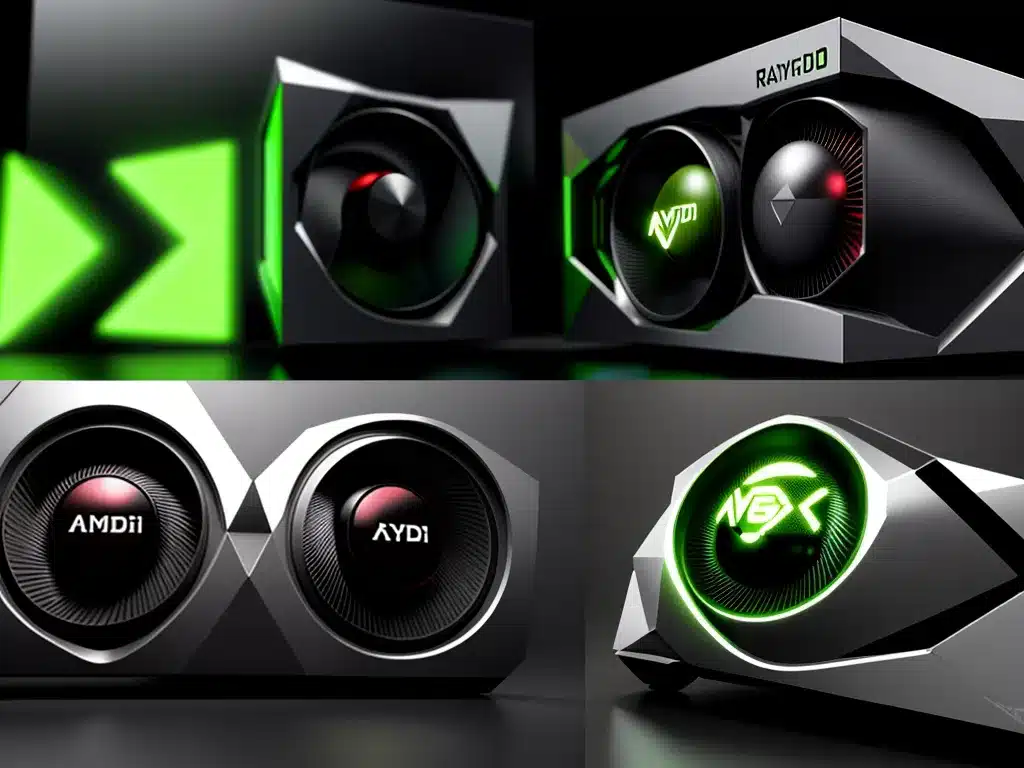Introduction
Ray tracing is a revolutionary rendering technique that enables photorealistic lighting effects in games and other graphics applications. Both AMD and NVIDIA have implemented hardware-accelerated ray tracing in their latest GPU architectures, RDNA 2 and Ampere respectively. In 2024, ray tracing will become more prevalent as developers optimize their implementations and new GPUs provide increased ray tracing performance. This article provides an in-depth comparison between AMD and NVIDIA’s ray tracing capabilities on their upcoming GPUs to help understand the strengths and weaknesses of each approach.
Ray Tracing Overview
Ray tracing simulates the physical behavior of light by tracing the path of light rays as they interact with objects in a 3D scene. It can deliver effects like accurate shadows, reflections, refraction and global illumination that are difficult to achieve with traditional rendering techniques.
Ray tracing works by shooting rays from the camera into the scene. When a ray hits an object, it can spawn secondary rays like reflection, refraction and shadow rays to simulate additional lighting effects. By tracking many light paths in this way, ray tracing can render photorealistic images. However, it requires tremendous computing power.
Hardware Acceleration
Dedicated ray tracing hardware like NVIDIA’s RT Cores and AMD’s Ray Accelerators speed up ray traversal and intersection calculations massively compared to running them on traditional shader cores. This enables real-time ray tracing in games.
Both AMD and NVIDIA have integrated ray acceleration units into their GPU architectures since 2018. Their implementations differ in the number of acceleration units and how they are utilized.
AMD RDNA 2 Ray Tracing Architecture
AMD’s RDNA 2 architecture powers their latest RX 6000 series GPUs with hardware-accelerated ray tracing. Here are the key features:
- Ray Accelerators – Dedicated units for accelerating bounding volume hierarchy (BVH) traversal and intersection testing.
- One Ray Accelerator per CU – RDNA 2 GPUs have one Ray Accelerator per Compute Unit (CU), allowing ray tracing to scale with core count.
- Mesh Shaders – Enables geometry processing for ray tracing to be offloaded from shader cores to dedicated mesh shading units.
- Variable Rate Shading – Improves ray tracing performance by selectively reducing shading rate in areas that don’t need full quality.
NVIDIA Ampere Ray Tracing Architecture
NVIDIA’s Ampere architecture in their RTX 30 series GPUs expands their ray tracing capabilities with:
- RT Cores – Dedicated cores to accelerate ray-triangle intersection and BVH traversal.
- 2nd Generation RT Cores – Redesigned for 2x throughput and support for concurrent ray tracing and shading.
- Up to 2 RT Core per SM – Ampere has up to 2 RT Cores per Streaming Multiprocessor (SM) depending on GPU model.
- 3rd Generation Tensor Cores – Enables AI-accelerated denoising for ray traced effects.
- Concurrent RT and Shading – RT Cores and shader cores can work simultaneously, improving ray tracing efficiency.
Performance Comparison
It’s challenging to provide definitive ray tracing performance comparisons between AMD and NVIDIA as performance depends heavily on the game, resolution, settings, and GPU model. However, some general observations:
- At lower resolutions, NVIDIA generally has higher ray tracing performance due to more RT cores and concurrent shading.
- At higher resolutions, performance gap narrows as shader utilization increases on AMD.
- AMD ray tracing performance scales well with high core count due to one Ray Accelerator per CU.
- NVIDIA’s AI-accelerated denoising provides higher ray tracing fidelity at lower cost.
- AMD GPUs offer better price-to-performance ratio for ray tracing.
As developers further optimize their ray tracing implementations for each architecture and new GPUs launch, the performance differences are likely to shift over time.
Real-Time Ray Tracing Effects
Both vendors support the DirectX Raytracing (DXR) API to deliver ray traced effects in real-time. Here are some key effects used in games:
- Ray-Traced Reflections – Accurate planar and curved reflections from glossy and metal surfaces.
- Ray-Traced Shadows – Soft, diffused shadows from area lights and environment illumination.
- Ray-Traced Ambient Occlusion – Improved contact shadows in small crevices and corners.
- Ray-Traced Global Illumination – Realistic bounce lighting from indirect illumination.
NVIDIA also offers RTX-specific effects like DLSS 2 with ray tracing, NVIDIA Optix ray tracing, and RTXGI ray-traced global illumination. AMD will likely introduce optimized ray tracing extensions in the future as well.
Future Outlook
Ray tracing is still in the initial adoption phase in games. Upcoming titles like Cyberpunk 2077 and the next-generation consoles will drive broader implementation of ray tracing.
Both AMD and NVIDIA are committed to advancing real-time ray tracing. Future GPU architectures will bring higher core counts, next-generation ray accelerators, and finer granularity control over ray tracing quality and performance.
AI-acceleration will play a bigger role in denoising and upscaling ray traced graphics. Ray tracing in the cloud for streaming games will also expand access to cinematic quality graphics.
The ray tracing ecosystem still has much room for optimization and innovation from GPU vendors, game developers, and content creators. Overall, the future looks bright for stunningly realistic real-time graphics!
Conclusion
Ray tracing represents the next evolution in game graphics, enabling photorealism on a new level. Both AMD and NVIDIA offer performant ray tracing architectures but NVIDIA currently has an edge in some ray tracing workloads due to their mature RT core implementation and AI-enhanced effects.
However, AMD RDNA 2 ray tracing delivers great price-to-performance ratio and will likely improve further over time. The competitor dynamics between Team Red and Team Green will continue to drive rapid advancements in ray tracing technology to the benefit of gamers and graphics professionals. 2024 will be an exciting time for jaw-dropping visuals powered by real-time ray tracing on both AMD and NVIDIA platforms.













